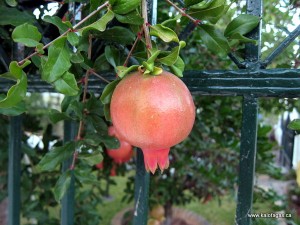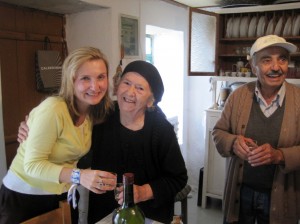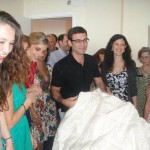
I once heard novelist Zadie Smith describe the several psychological stages an author goes through while writing a novel. Based on my own experience, she was right on about all of them–the self-consciousness bordering on self-hatred when things aren’t going well, and that experience when things are where everything you see, read, or hear, seems to relate to your book, for example :”the sky’s blue today and there’s a mule in my book named Blue–clearly that’s a sign that I have my finger on the pulse of the universe!”
I’ve had that feeling of synchronicity while writing my novel, but occasionally I have it in my life as well, when you see something and it serves as a confirmation of everything you already knew. That happened to me two days ago when I got the daily link to one of my favorite blogs, kalofagas.ca (a tribute to Greek food and culture) and saw the gorgeous photo above and the words, “It’s October and that means it’s pomegranate season.”
October is my favorite month, because of the autumn leaves in Massachusetts where I grew up, because of the lovely weather in most parts of the world, and because of my birthday on the 8th (and, now, my anniversary on the 10th). And readers of this blog and admirers of my logo know, the pomegranate is my favorite fruit and folkloric symbol. (And how could one not admire this bright, idiosyncratic logo designed by Thoma Kikis as part of the website crafted by brandiD.) As the pomegranate council writes, the fruit is “symbolic of prosperity and abundance in virtually every civilization.”
Some believe that the forbidden fruit in the garden of Eden was a pomegranate, not an apple (which makes sense when you think of the garden of Eden as being located, in all likelihood, in the Middle East). And in Greek mythology, it’s the fruit from which Persephone at seven juicy seeds, condemning herself to (or guaranteeing that she would?) spend half the year underground in the kingdom of Hades. In my own personal creation myth, it’s the fruit that added the finishing touch to my wedding on the Greek island of Corfu.

One year ago today a caravan of celebrants including my parents, aunt, sister, my dear friend and her husband and parents, and my fiancé, his mother, and his friend woke up in Lia, the Greek mountain village where my father was born and where I spent a year rebuilding my grandparents’ house and researching my travel memoir, North of Ithaka, and tromped off through the mist to the home of an older couple who lived opposite the church. They have a lush pomegranate tree so studded with fruit that it sometimes falls into the road, and that the policemen doing their rounds through town grab fruit of the tree for a snack (with the owners’ permission). The couple invited us in for moonshine (it being 10 AM, so cocktail hour), regaled us with tales of their own marriage (marrying young, they’d been together for over half a century) and let us pick pomegranates from their tree to adorn our wedding table. We then drove the pomegranates, and ourselves, down the mountain to the port of Igoumenitsa, took the ferry to Corfu, and gave them to the florist who used them to decorate the tables at our reception. They sat there, plump and rosy symbols of fertility, working their magic; my friend and I, who had both picked the pomegranates, are now both new mothers of sassy baby daughters.
 But the pomegranates weren’t the only fertility ritual at my wedding (why settle for one ritual when two will do, I always say? When it comes to folklore, more is definitely more!). On October 8th, 2010, I hosted a cocktail party in my hotel suite which coincided with the Making of the Bed. In this traditional ritual, all the bride’s single friends make up the connubial bed on which the couple will spend the wedding night. Legend has it that she who gets the pillowcase on first will be the next to marry. Once the task is done, relatives shower the bed with rice (for fertility), Jordan almonds (which remind us that life is both bitter and sweet), rose petals, and cash, including gold sovereigns. Then small children bounce on the heaping bed, symbolizing the children the couple will have (you can rig it so that a girl bounces first if you want a daughter, a boy if you want a son).
But the pomegranates weren’t the only fertility ritual at my wedding (why settle for one ritual when two will do, I always say? When it comes to folklore, more is definitely more!). On October 8th, 2010, I hosted a cocktail party in my hotel suite which coincided with the Making of the Bed. In this traditional ritual, all the bride’s single friends make up the connubial bed on which the couple will spend the wedding night. Legend has it that she who gets the pillowcase on first will be the next to marry. Once the task is done, relatives shower the bed with rice (for fertility), Jordan almonds (which remind us that life is both bitter and sweet), rose petals, and cash, including gold sovereigns. Then small children bounce on the heaping bed, symbolizing the children the couple will have (you can rig it so that a girl bounces first if you want a daughter, a boy if you want a son).
 The fun Corfiot wrinkle to this tradition, which my cousins explained to me once I arrived, is that the groom is supposed to come in and inspect the bed (after it’s made, but before it’s showered with fertility symbols) and pronounce it unworthy, pulling off the sheets twice so that the maidens have to remake it, and approving it only when it’s been made a third time.
The fun Corfiot wrinkle to this tradition, which my cousins explained to me once I arrived, is that the groom is supposed to come in and inspect the bed (after it’s made, but before it’s showered with fertility symbols) and pronounce it unworthy, pulling off the sheets twice so that the maidens have to remake it, and approving it only when it’s been made a third time.
Right before Emilio entered to view the bed, my BFF Glenn, a nice Jewish boy from Yonkers who jumped right into the spirit of this obscure Greek tradition, advised him, “Channel Pacino.” Emilio did, growling, “You call this a bed?” and tearing off the sheets twice before agreeing the made bed would do.
 Almost a year later, I made Emilio–ever the good sport–channel Pacino again, in a photo we emailed to friends who are Scarface fans, along with text inviting them to “say hello to our little friend,” paraphrasing the famous film. The role of the machine gun was played by Amalía, the product of all the fertility rituals. She looks a little unhappy with her precarious position in the photo, but when she’s older, I’m sure she’ll approve, because nothing is more fun than mixing an ancient custom with modern media. Especially in October, the month of the pomegranate.
Almost a year later, I made Emilio–ever the good sport–channel Pacino again, in a photo we emailed to friends who are Scarface fans, along with text inviting them to “say hello to our little friend,” paraphrasing the famous film. The role of the machine gun was played by Amalía, the product of all the fertility rituals. She looks a little unhappy with her precarious position in the photo, but when she’s older, I’m sure she’ll approve, because nothing is more fun than mixing an ancient custom with modern media. Especially in October, the month of the pomegranate.